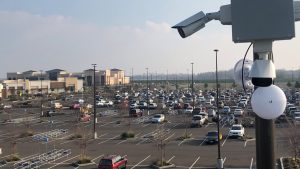Looking for security cameras?
Contact Us. We can help.
When you decide to buy security cameras, you’re going to be met with plenty of options, probably more than you care to review. So, to save time (and money), it’s best to walk in prepared. The first step is to have a solid idea of what your video surveillance needs are. Are you buying security cameras indoors, outdoors, or both? Are they going to be exposed to the elements? Is the range (depth of field) of the camera a high priority, or do you want something that can cover a wide-angle in a single frame? These are just a few of the questions you’ll want to have answers to before you start looking for hardware (it’ll save you a boatload of time).
Even if you’ve never researched security cameras before, there are two types you’re probably familiar with: bullet cameras and dome cameras. You know them because you see them everywhere: malls, stores, transit stops, hospitals, manufacturing plants, refineries…the list goes on.
In this blog, we’ll get into the pros and cons of each to help you decide which one of these camera types are best suited for your application. Keep reading to learn more and, if you have any questions, you can Contact Us anytime.
Dome Cameras: The Advantages
They’re Discreet
While they may still be noticeable, dome cameras are far more discreet than bullet cameras. They come in a range of sizes, making it easy to find one that fits your requirements for aesthetics and discretion. You’ll often find these installed in stores, hotels, transit hubs, and on transit vehicles like buses or the LRT.
They’re Less Prone to Vandalism (and Nesting Birds)
One of the drawbacks of bullet cameras is that they are easy to vandalize. They can be damaged by thrown objects; they can be forced into different positions, so they don’t monitor and record the area you had intended. Dome cameras can’t be tampered with as easily.
The clear dome protects the cameras inside; that means thrown objects won’t affect your ability to record. And, because the actual cameras are protected by the dome, it’s much harder for thieves and vandals to redirect them. While they aren’t impervious to damage, they are very durable.
Another benefit to their design is that they don’t provide a perch for birds. Silly as it may sound, the size and shape of bullet cameras can provide a perch for birds and a base for bird nests. That can lead to maintenance issues as well as logistical challenges if environmental legislation requires you to relocate or protect the nest until the birds move on.
Wider Angles in a Single Frame
A benefit of using dome cameras is that they can capture a wide-angle in a single frame. Because of that, you’ll probably see them monitoring widespread workplaces, like the front desk of a hotel or the interior of a bus or LRT car. The design of dome cameras means they have a wider angle of view, allowing them to provide a near-panoramic perspective and high-definition imagery and video.
Dome Cameras: The Disadvantages
Limited Range
We just mentioned a dome camera’s ability to capture wide-angle shots and footage. Well, one of the trade-offs is the limited range. Dome cameras aren’t the ideal choice for capturing high-quality images and footage of subjects at a distance. That means they are better suited for use indoors rather than outdoors.
The Domes Get Dirty
While dome cameras may be harder to vandalize, they aren’t completely maintenance-free. Dirt and dust can still build up on the dome, and that can make obtaining usable evidence more difficult. The domes will have to be cleaned regularly to make sure this doesn’t happen.
Harder to Reposition
The wide angles captured by dome cameras come at another cost: it’s static. That means if you want to capture a different angle (field of view) you have to reposition the camera. A bullet camera, on the other hand, would give you a bit more flexibility; you may be able to simply pan the camera left or right and capture the field of view you want.
Bullet Cameras: The Advantages
Visible Deterrence
Bullet cameras are not subtle, and that can be a good thing. One of the main reasons companies and homeowners invest in video surveillance is to deter reckless and criminal activity rather than just capturing the evidence of it. If would-be thieves and vandals know that their actions are being watched and recorded, they may think twice about trying anything on your property.
Longer and Wider Range
While a dome camera may be able to capture a wider angle in a single frame, it can’t pan from left to right. The fact that they are stuck in one position means that they may not be the best for monitoring areas with a lot of movement, like a parking lot or a warehouse floor.
Bullet cameras, on the other hand, can pan from left to right. They may not be able to capture the same wide-angle in a single shot, but they can reposition to get a better view on subjects of interest. Their design also means they are better suited for longer-range recording. For example, if you wanted to capture footage of a person or vehicle at the far end of a parking lot, a bullet camera would be the tool of choice.
Easy to Reposition
If your bullet camera isn’t capturing the information you need, it can be easily repositioned to do so. This can be done remotely or at the camera itself, depending on the model you are using. While there may come a time that the camera has to be remounted, the need to do that will show up far less often.
Bullet Cameras: The Disadvantages
More Susceptible to Vandals (and Birds)
Because bullet cameras are easier to spot and damage than dome cameras, they are more prone to vandalism. Criminals may be able to damage them with thrown objects, reposition them manually, or interfere with the camera’s ability to record. If that happens, evidence of an incident could go unrecorded, seriously setting back any attempt at an investigation.
The size and shape of bullet cameras also mean that birds might make them a perch, or even the base for a nest. There may be installation techniques that limit the chance of this happening, but if it does, operating or repositioning the camera could be a challenge.
They Don’t Blend In
The obvious presence of a security camera can be a bit of a double-edged sword. It certainly acts as a stronger deterrent than more discreet camera options, but the presence of bullet cameras can throw off the aesthetic appeal of an environment. If you’re trying to monitor a manufacturing plant or parking complex, that may not be a big deal. But in hotels, universities, stores, and office towers, it can become an issue.
Getting Started
Ultimately, your security solution will probably consist of both bullet and dome cameras, and maybe a couple of others, too. The determining factors will be the complexity of your security needs and goals, the environment you want to monitor, and, of course, your budget.
If you’re ready to start planning your security system, or if you just have some questions about what cameras to use (and where), Contact Us. Our Engineers, Technicians, and Account Managers are here to build a futureproofed system that achieves your objectives and meets your budget. We’re here to help.
Tridon is a full solution Telecom Systems Integrator with CSA certification and licensed by APEGA. Our Engineering, Service, and Tower Divisions collaborate with customers to build engineered solutions including communications systems design, tower inspections, and co-location, wireless broadband, fiber optic cabling, site security, and two-way radio communication.




